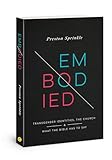Of the many books concerning Christianity and LGBT topics, most have addressed the front end of the acronym, leaving the back end woefully neglected. Yet questions of gender identity are growing in volume and urgency, both within and outside the church. In his latest book, Embodied: Transgender Identities, the Church, and What the Bible Has to Say, Preston Sprinkle, president of the Center for Faith, Sexuality & Gender, provides guidance on addressing these questions constructively and lovingly. Author and Cru leader Rachel Gilson spoke with Sprinkle about his book.
Embodied: Transgender Identities, the Church, and What the Bible Has to Say
David C Cook
288 pages
$13.64
Why this book, and why now?
There are two emphases woven together in the book: a people strand and a conceptual strand. I’m focused, in other words, on loving people well while also thinking biblically, logically, and scientifically on all the topics that gender-identity conversations stir up: male and female sexual embodiment, relationships between body and soul, and gender stereotypes surrounding masculinity and femininity. We can’t just do one without the other. Thinking carefully without loving well leads to damage just as surely as loving well without thinking carefully.
Did any of your views change while researching and writing?
I certainly gained a stronger appreciation for some of the finer nuances of these conversations. For example: One common question is whether someone can be born in the “wrong” body. My hunch going in was: no. Having wrestled with that question from several angles, I haven’t changed my mind. But I can better understand why some make this claim.
How much of your personhood is due to your brain, and how much to your body? That’s a complex question! It brings in neuroscience, philosophy, theological anthropology, and other perspectives on human nature. There are more complexities than our culture-war framework acknowledges.
In conversations about gender, intersex people often get used as mascots. Sometimes they’re lumped in with the trans populations, and on other occasions they’re ignored entirely. How can we care well for people whose bodies aren’t fully male or female in a conventional sense?
Intersex people are often like the kid caught in a divorce, pulled in different directions and utilized in service of one argument or another. As several intersex people have pointed out, this feels dehumanizing.
If we’re going to discuss the subject of intersex conditions, let’s make sure we’re not doing so in passing, as a stepping stone toward something else. There are important questions, in their own right, about newborns whose sex is ambiguous: Should they be operated on right away? And who gets to determine which sex is the preferred outcome? These are big concerns within the intersex community. There are overlaps, of course, with conversations on transgender identity, but the point remains that we can’t just employ intersex conditions in service of a broader ideological argument about gender and sexuality.
For those who don’t identify as trans or intersex, how do we enter into this conversation? What are some dos and don’ts?
First, listen to actual trans people—especially if you’re coming from a more conservative Christian environment. Sometimes that environment can harden our hearts toward those who have been marginalized, shamed, or shunned by the church, and the trans population often fits that description. To shave off the harsh edges of our posture, we need to maintain genuine relationships with trans people.
Second, we need to learn the right language—understanding, for instance, the difference between sex and gender, what gender identity means, and why words like “transgenderism” can be a turnoff. As one of my trans friends told me, “‘trangenderism’ feels like a nameless, faceless concept that people can vilify.” To many people, it can sound uncomfortably like a disease. Certain words convey certain unintended meanings, and that’s important to get clear.
Many people use sex and gender interchangeably. What is the difference?
It’s beyond dispute that humans are sexually dimorphic: We reproduce only when a male impregnates a female, and these categories are basic to our humanity. Scripture attests to this, stating that God created human beings as male and female (Gen. 1:27).
Gender, by contrast, deals with our psychological and social response to biological sex. Under that umbrella, you can identify three categories. Gender identity is our internal sense of who we are—whether we resonate with being male or female. Gender expression is how we manifest inward identity, typically with clothing or mannerisms that suggest masculinity or femininity. And gender roles refer to societal expectations for males and females. These concepts are related but still distinct.
Some Christians might hear your answer above and think, “That sounds reasonable, but the Bible doesn’t speak in those categories. What am I supposed to do with them?”
While the Bible doesn’t have a term like gender that’s used in distinction to sex, I think it does speak to the differences those words signify. It recognizes, of course, that humans are created male and female. And it does depict behavior that we might consider masculine or feminine.
In the Greco-Roman world, there were certain expectations that came with being male or female. You might be a biological male, but if you were kind to the marginalized, say, or washed people’s feet, you might be stigmatized as unmanly. While the Bible celebrates sex difference, it also challenges certain cultural stereotypes. Take someone like King David: He was a great warrior and cut the head off Goliath, but he wrote poetry, played the harp, and cried a lot. Or take the Book of Judges, where women like Deborah or Jael play crucial roles in military battles. Scripture has a more expansive vision, then, for what it means to live out our male and female identities.
We both have friends who identify as trans or nonbinary Christians. What would you say to believers who are suspicious about those labels?
Terms like trans or transgender can mean different things to different people. I have a biologically male friend, for instance, who calls himself transgender because he identifies as a woman. That’s the kind of usage that comes to mind most commonly. Another friend of mine is biologically female, and believes she’s female, but calls herself trans because she experiences gender dysphoria. So while some people use these terms to speak about their fundamental personhood, others use them mainly to describe their subjective experience.
Sometimes, it’s as simple as feeling like you don’t match a particular set of gender stereotypes. Often enough, that’s all nonbinary means—not that you don’t believe you’re biologically male or female, but that you don’t completely resonate with either masculinity or femininity. In the end, the only way to avoid confusion is getting to know the people themselves—and learning why they use the words they use.
What should trans readers take away from your book? And what about non-trans readers?
For my trans readers, I want them to feel seen and understood. I would never presume to tell them about their own lived experiences, but conceptually, I hope they find greater clarity about what science and Scripture do and don’t say. After all, many trans friends will remind me that they aren’t experts on these matters. They don’t necessarily have an airtight grasp of a biblical theology of gender—or even gender dysphoria itself.
As I say in my preface, however, my primary audience is non-trans people. I hope they’ll come away no longer scared of this conversation. Because if you’re scared of this conversation, you’ll likely be scared of trans people themselves. And that’s not a posture any Christian leader should have.











